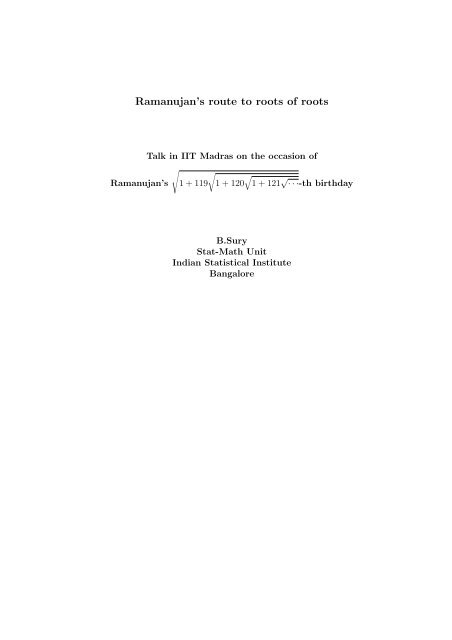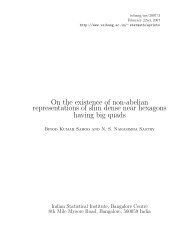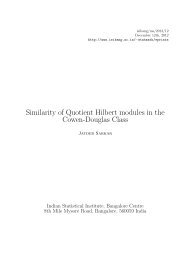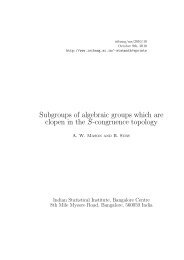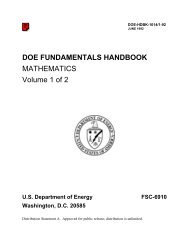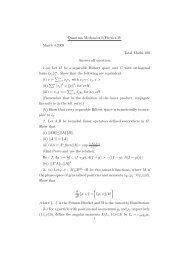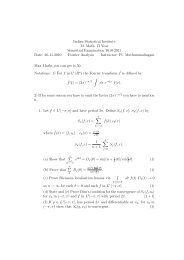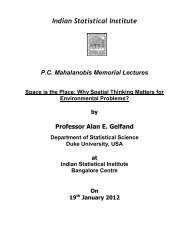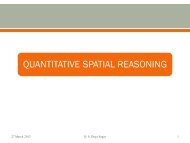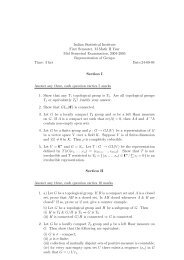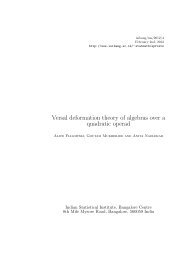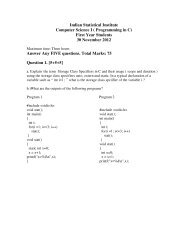Ramanujan's route to roots of roots - Indian Statistical Institute
Ramanujan's route to roots of roots - Indian Statistical Institute
Ramanujan's route to roots of roots - Indian Statistical Institute
Create successful ePaper yourself
Turn your PDF publications into a flip-book with our unique Google optimized e-Paper software.
Ramanujan’s <strong>route</strong> <strong>to</strong> <strong>roots</strong> <strong>of</strong> <strong>roots</strong><br />
Talk in IIT Madras on the occasion <strong>of</strong><br />
√ √ √<br />
Ramanujan’s 1 + 119 1 + 120 1 + 121 √· · ·-th birthday<br />
B.Sury<br />
Stat-Math Unit<br />
<strong>Indian</strong> <strong>Statistical</strong> <strong>Institute</strong><br />
Bangalore
Introduction<br />
The fancy title points out <strong>to</strong> a subject which originated with Ramanujan or,<br />
at least, one <strong>to</strong> which he gave crucial impetus <strong>to</strong>. We can’t help but feel a<br />
sense <strong>of</strong> bewilderment on encountering formulae such as<br />
√<br />
√ √ √<br />
3 3√<br />
3 1 2 4 2 − 1 =<br />
9 − 3 9 + 3 9 ;<br />
3<br />
√<br />
3√ √ 3<br />
28 − 27 = − 1 3 (− 3√ 98 + 3√ 28 + 1);<br />
√<br />
3√ √ 3<br />
5 − 4 = 1 3 (− 3√ 25 + 3√ 20 + 3√ 2);<br />
√cos 2π 7 + 3 √cos 4π 7 + 3 √cos 8π 7 = 3 √<br />
√<br />
√ √<br />
6<br />
7 3√ 5 2<br />
20 − 19 = 3 3 − 3 3 ;<br />
5 − 3 √ 7<br />
;<br />
2<br />
√<br />
√<br />
8 − 8 + √ 8 − · · · = 1 + 2 √ 3 sin 20 ◦ ;<br />
√<br />
√<br />
√<br />
23 − 2 23 + 2 23 + 2 √ 23 − · · · = 1 + 4 √ 3 sin 20 ◦ ;<br />
√<br />
e −2π/5 e −2π e −4π e −6π<br />
1+ 1+ 1+ 1+ · · · = 5 + √ √<br />
5 5 + 1<br />
− .<br />
2 2<br />
The last expressions for the so-called Rogers-Ramanujan continued fraction<br />
appeared in Ramanujan’s first letter <strong>to</strong> Hardy. These formulae are among<br />
some problems posed by Ramanujan in the Journal <strong>of</strong> the <strong>Indian</strong> Mathematical<br />
Society. As was usual with Ramanujan, he had a general formula hidden<br />
in the background and, singled out striking special cases in these problem<br />
sections. Usually, a study <strong>of</strong> his notebooks revealed what general formula he<br />
had in mind. The first thing <strong>to</strong> notice is that radicals are multi-valued and<br />
the meaning <strong>of</strong> expressions where radicals appear has <strong>to</strong> be made clear. Specially,<br />
where there is a ‘nesting’ <strong>of</strong> radicals, the level <strong>of</strong> complexity increases<br />
exponentially with each radical sign and it is computationally important <strong>to</strong><br />
have equivalent expressions with the least number <strong>of</strong> radical signs. One more<br />
point <strong>to</strong> note is that <strong>of</strong>ten an equality, once written down, is almost trivial<br />
2
<strong>to</strong> verify simply by taking appropriate powers and simplifying. Thus, the<br />
intriguing question is <strong>to</strong> find out how such a formula was discovered and how<br />
<strong>to</strong> determine other such identities. The appropriate language <strong>to</strong> analyse this<br />
problem is the language <strong>of</strong> Galois theory.<br />
1 The identity in the title<br />
We briefly discuss the title expression and go on <strong>to</strong> analyze the other expressions<br />
in the next sections. A beautiful, elementary discussion <strong>of</strong> the<br />
convergence and evaluation <strong>of</strong> these expressions appears in an article written<br />
by Shailesh Shirali in Resonance.<br />
Ramanujan posed the problem <strong>of</strong> finding the values <strong>of</strong> :<br />
√<br />
√<br />
1 + 2 1 + 3 √ 1 + · · ·<br />
and<br />
√<br />
√<br />
6 + 2 7 + 3 √ 8 + · · ·.<br />
These are special cases <strong>of</strong> Ramanujan’s theorem appearing as Entry 4 on<br />
page 108, chapter 12 <strong>of</strong> his second notebook. Leaving aside the questions<br />
<strong>of</strong> convergence <strong>of</strong> these infinite radicals, the values can easily be discovered.<br />
Indeed, (keeping in mind the title expression), it is better <strong>to</strong> look at the more<br />
general form <strong>of</strong> the first expression<br />
√<br />
√<br />
√<br />
f(x) = 1 + x 1 + (x + 1) 1 + (x + 2) √ 1 + · · ·<br />
for x > 0. What is the meaning <strong>of</strong> this? One is looking <strong>to</strong> find functions<br />
f : [0, ∞) → [0, ∞) satisfying<br />
√<br />
f(x) = 1 + xf(x + 1).<br />
As f(x) ≥ 1, we have<br />
f(x) ≤<br />
√<br />
(1 + x)f(x + 1) ≤ √ 1 + x<br />
√ √<br />
(2 + x)f(x + 2) ≤ · · ·<br />
Thus, f(x) ≤ ∏ ∞<br />
k=1 (k + x) 1<br />
2 k .<br />
For x ≥ 1, it is easy <strong>to</strong> bound the above infinite product above as<br />
∞∏<br />
(k + x) 1<br />
k=1<br />
2 k ≤<br />
k=1<br />
∞∏<br />
∞∏<br />
(2kx) 1<br />
2 k = 2x<br />
k=1<br />
3<br />
k 1<br />
2 k < 2x<br />
∞∏<br />
k=1<br />
2 k−1<br />
2 k ≤ 4x.
In other<br />
√<br />
words, for any x<br />
√<br />
≥ 0, we have f(x + 1) < 4(x + 1) and, therefore,<br />
f(x) = 1 + xf(x + 1) < 1 + 4x(x + 1) = 2x+1. A fortiori, f(x) < 4x+1<br />
for any x ≥ 0.<br />
Playing the same game, if f(x) ≤ ax + 1 for some a > 0 (and all x ≥ 0), we<br />
get - on using f(x + 1) ≤ a(x + 1) + 1 - that<br />
f(x) ≤<br />
√<br />
√<br />
1 + (a + 1)x + ax 2 ≤ 1 + (a + 1)x + ( a + 1<br />
2 x)2 ≤ 1 + a + 1<br />
2 x.<br />
Hence, starting with a = 4, we have the inequality f(x) ≤ ax + 1 recursively<br />
for a = 5, 7, 11 etc. which is a sequence converging <strong>to</strong> 1. Thus, f(x) ≤ 1 + x<br />
2 4 8<br />
for all x√<br />
≥ 0. Similarly, using the fact that f(x + 1) ≥ f(x), one has<br />
f(x) ≥ 1 + xf(x) which gives f(x) ≥ 1 + x for x ≥ 0. The earlier trick<br />
2<br />
<strong>of</strong> iteration gives us that if a > 0 satisfies f(x) ≥ 1 + ax for all x ≥ 0, then<br />
f(x) ≥ 1+ √ ax. Thus, starting with a = 1 1<br />
, we get f(x) ≥ 1+ax for a =<br />
2 2<br />
for all k ≥ 1. The latter sequence converges <strong>to</strong> 1 and we therefore have 1/2k<br />
a<br />
perfect sandwich (which probably Ramanujan survived on, in England !) <strong>to</strong><br />
get f(x) = 1 + x for all x ≥ 0. Therefore,<br />
√<br />
√<br />
1 + 2 1 + 3 √ 1 + · · · = 3(!)<br />
We leave the reader <strong>to</strong> ponder about the value <strong>of</strong><br />
√<br />
√<br />
6 + 2 7 + 3 √ 8 + · · ·.<br />
2 A theorem <strong>of</strong> Ramanujan<br />
Ramanujan proved :<br />
If m, n are arbitrary, then<br />
√<br />
m 3√ 4m − 8n + n 3√ 4m + n =<br />
± 1 3 ( 3 √<br />
(4m + n) 2 + 3 √<br />
4(m − 2n)(4m + n) − 3 √2(m − 2n) 2 ).<br />
As mentioned above, this is easy <strong>to</strong> verify simply by squaring both sides !<br />
However, it is neither clear how this formula was arrived at nor how general<br />
it is. Are there more general formulae? In fact, it turns out that Ramanujan<br />
4
was absolutely on the dot here; the following result shows Ramanujan’s result<br />
cannot be bettered :<br />
√<br />
Let α, β ∈ Q ∗ such that α/β is not a perfect cube in Q. Then, 3√ √ α +<br />
3<br />
β<br />
can be denested if and only if there are integers m, n such that α = (4m−8n)m3 .<br />
β (4m+n)n 3<br />
√<br />
For instance, it follows by this theorem that<br />
3√ √ 3 +<br />
3<br />
2 cannot be denested.<br />
What is meant by denesting ?<br />
By the denesting <strong>of</strong> a nested radical one means rewriting it with fewer radical<br />
symbols. More formally, over any field K, nested radicals are defined as<br />
follows. Start with the elements in K - these are said <strong>to</strong> be nested radicals <strong>of</strong><br />
depth zero. Use addition, subtraction, product, division and n√ x for n ≥ 2 <strong>to</strong><br />
form expressions (possibly not in K as we are taking n-th <strong>roots</strong>). With the<br />
expressions so formed, one can apply all the above procedures <strong>to</strong> form new<br />
expressions. Thus, a nested radical is an expression obtained from earlierformed<br />
nested radicals by means <strong>of</strong> these procedures. One defines the depth<br />
dep = dep K <strong>of</strong> a nested radical over K inductively by :<br />
depth (x) = 0 for x ∈ K;<br />
depth (x ± y) = depth (x.y) = depth (x/y) = max (depth x, depth y);<br />
depth n√ x = 1+ depth x.<br />
The usual convention used in fixing the values <strong>of</strong> radical expressions is as<br />
follows. An expression 3√ t for a real number t will stand for the unique real<br />
cube root and, if s is a positive real number, √ s stands for the value which<br />
is the positive square root.<br />
For example, the expression 3√ √ √ √<br />
3<br />
5 + 2 − 5 − 2 has value 1 !<br />
Indeed, if t is the value (according <strong>to</strong> the agreed-upon convention above), then<br />
t is seen <strong>to</strong> be a (real) root <strong>of</strong> the polynomial X 3 +3X −4. As X 3 +3X −4 =<br />
(X − 1)(X 2 + X + 4), the only real root is 1.<br />
3 Galois theory for denesting<br />
√<br />
To denest an expression such as 3√ √ α +<br />
3<br />
β, one needs <strong>to</strong> locate a field where<br />
the denesting exists. Usually, one will need <strong>to</strong> go <strong>to</strong> a field where enough<br />
<strong>roots</strong> <strong>of</strong> unity exist. Let K be any field <strong>of</strong> characteristic zero and let ¯K be an<br />
algebraic closure. The definition <strong>of</strong> depth over a field K implies that there<br />
are subfields K (d) <strong>of</strong> ¯K defined by depthK (x) = d for x ∈ ¯K if and only if<br />
5
x ∈ K (d) \ K (d−1) . Here, K (d) is generated by radicals over K (d−1) . In fact,<br />
K (d) := {x ∈ ¯K √<br />
: x n ∈ K (d−1) }.<br />
6<br />
For example, 7 3√ √<br />
20 − 19 = 3 5 − √ 3 2<br />
shows that the element on the left<br />
3 3<br />
side which is in Q (2) is actually contained in Q (1) itself.<br />
An element x ∈ ¯K is a nested radical over K if and only if there exists a<br />
Galois extension L <strong>of</strong> K and a chain <strong>of</strong> intermediate fields<br />
K ⊂ K 1 ⊂ · · · ⊂ K n = L<br />
such that K i is generated by radicals over K i−1 and x ∈ L.<br />
Normally, if an element x is a nested radical over K, one obtains a chain<br />
as above successively generated by radicals such that x ∈ L but L may not<br />
be au<strong>to</strong>matically a Galois extension. For example, the left hand side above<br />
generates a non-Galois extension <strong>of</strong> Q and one needs <strong>to</strong> attach the 6-th <strong>roots</strong><br />
<strong>of</strong> unity <strong>to</strong> get a Galois extension containing it.<br />
So, why is it so important/useful <strong>to</strong> have a Galois extension ?<br />
The fact <strong>of</strong> the matter is that Galois’s famous theorem tells us that x ∈ ¯K is a<br />
nested radical if and only if the Galois closure <strong>of</strong> K(x) over K has a solvable<br />
Galois group. Thus, the extensions K (d) , if they are Galois extensions <strong>of</strong><br />
K (d−1) , have an abelian Galois group and this theory is well-studied under<br />
the title <strong>of</strong> ‘Kummer theory’. Therefore, one may adjoin enough <strong>roots</strong> <strong>of</strong><br />
unity at the first step <strong>of</strong> the chain <strong>to</strong> get a chain <strong>of</strong> Galois extensions and<br />
may apply Kummer theory.<br />
For instance,<br />
Q ⊂ Q(ζ 6 ) ⊂ Q( 3√ 20, ζ 6 ) ⊂ Q( 6 √7 3√ 20 − 19, ζ 6 )<br />
is a chain with each successive extension abelian.<br />
Roughly speaking, Kummer theory can be summarized by the following :<br />
Main Theorem <strong>of</strong> Kummer theory.<br />
If K contains the n-th <strong>roots</strong> <strong>of</strong> unity, then abelian extensions L <strong>of</strong> K whose<br />
Galois groups have exponent n correspond bijectively <strong>to</strong> subgroups Ω <strong>of</strong> K ∗<br />
containing (K ∗ ) n via L ↦→ K ∗ ∩ (L ∗ ) n and its inverse map Ω ↦→ K(Ω 1/n ).<br />
Using Kummer theory, one may analyze all nested radicals x over Q. In this<br />
talk, we do not go in<strong>to</strong> the details <strong>of</strong> this general result proved by M.Honsbeek<br />
in 1999 but focus mainly on the result relevant <strong>to</strong> Ramanujan’s theorem. We<br />
will use the notation Q for the field <strong>of</strong> all algebraic numbers. In this field,<br />
every nonconstant polynomial over it has all its <strong>roots</strong> in it. The following<br />
6
consequence <strong>of</strong> the above main theorem <strong>of</strong> Kummer theory and will be a key<br />
<strong>to</strong> denesting radicals.<br />
Proposition 1.<br />
Let K denote a field extension <strong>of</strong> Q containing the n-th <strong>roots</strong> <strong>of</strong> unity. Suppose<br />
a, b 1 , b 2 , · · · , b r ∈ Q ∗ are so that a n , b n 1, · · · , b n r ∈ K.<br />
Then, a ∈ K(b 1 , · · · , b r ) if, and only if, there exist b ∈ K ∗ and natural numbers<br />
m 1 , m 2 , · · · , m r such that<br />
a = b<br />
r∏<br />
i=1<br />
b m i<br />
i .<br />
Pro<strong>of</strong>.<br />
The ‘if’ part is easily verified. Let us assume that a ∈ L := K(b 1 , · · · , b r ). The<br />
subgroup Ω <strong>of</strong> L ∗ generated by the n-th powers <strong>of</strong> elements <strong>of</strong> (K ∗ ) along with<br />
b n 1, · · · , b n r satisfies L = K(Ω 1/n ) by Kummer theory. So, a n ∈ (L ∗ ) n ∩K ∗ = Ω.<br />
Thus, there exists c ∈ K ∗ so that<br />
a n = c n<br />
r∏<br />
i=1<br />
b m in<br />
i .<br />
Taking n-th <strong>roots</strong> on both sides and multiplying by a suitable n-th root <strong>of</strong><br />
unity (remember they are in K), we get<br />
a = b<br />
r∏<br />
i=1<br />
for some b ∈ K ∗ . The pro<strong>of</strong> is complete.<br />
The following technical result from Galois theory which uses the above proposition<br />
is crucial in the denesting <strong>of</strong><br />
√ √1 + 3 β/α over Q. Although this result<br />
is not difficult <strong>to</strong> prove, we shall not go in<strong>to</strong> the details <strong>of</strong> the pro<strong>of</strong>. We give<br />
a sketch for the cognoscenti; others may skip it.<br />
Theorem 2.<br />
Let c be a rational number which is not a perfect cube. Let δ ∈ Q( 3√ c)<br />
and let G denote the Galois group <strong>of</strong> the Galois-closure M <strong>of</strong> Q( √ δ) over<br />
Q. Then, the nested radical √ δ can be denested over Q if, and only if, the<br />
second commuta<strong>to</strong>r group G ′′ <strong>of</strong> G is trivial. Further, these conditions are<br />
equivalent <strong>to</strong> the existence <strong>of</strong> f ∈ Q ∗ and some e ∈ Q(δ) so that δ = fe 2 .<br />
b m i<br />
i<br />
7
Sketch <strong>of</strong> Pro<strong>of</strong>.<br />
The essential part is <strong>to</strong> show that when G ′′ is trivial, then there are f ∈ Q ∗<br />
and e ∈ Q(δ) with δ = fe 2 .<br />
We consider the field K = Q(δ, ζ 3 ), the smallest Galois extension <strong>of</strong> Q which<br />
contains δ. If δ 2 , δ 3 are the other Galois-conjugates <strong>of</strong> δ in K, the main<br />
claim is that if δ 2 δ 3 is not a square in K, then G ′′ is not trivial. To see<br />
this, suppose δ 2 δ 3 (and hence its Galois-conjugates δδ 3 , δδ 2 ) are non-squares<br />
as well. Then, √ δδ 2 cannot be contained in K( √ δ 2 δ 3 ) because <strong>of</strong> the above<br />
proposition. So, the extension L = K( √ δδ 2 , √ δ 2 δ 3 ) has degree 4 over K and<br />
is contained in the Galois closure M <strong>of</strong> Q( √ δ) over Q. The Galois group<br />
Gal (L/K) is the abelian Klein 4-group V 4 . Indeed, its nontrivial elements<br />
are ρ 1 , ρ 2 , ρ 1 ρ 2 where :<br />
ρ 1 fixes √ δδ 2 and sends √ δ 2 δ 3 and √ δδ 3 <strong>to</strong> their negatives;<br />
ρ 2 fixes √ δ 2 δ 3 and sends √ δδ 2 and √ δδ 3 <strong>to</strong> their negatives.<br />
Also, Gal (K/Q) is the full permutation group on δ, δ 2 , δ 3 . We also put δ 1<br />
instead <strong>of</strong> δ for convenience.<br />
Suppose, if possible, G ′′ = {1}. Now, the second commuta<strong>to</strong>r subgroup <strong>of</strong><br />
Gal (L/Q) is trivial as it is a subgroup <strong>of</strong> G ′′ . In other words, the commuta<strong>to</strong>r<br />
subgroup <strong>of</strong> Gal (L/Q) is abelian.<br />
Consider the action <strong>of</strong> Gal(K/Q) on Gal (L/K) defined as :<br />
(σ, τ) ↦→ σ L τσ −1<br />
L<br />
where, for σ ∈Gal (K/Q), the element σ L ∈Gal (L/Q) which restricts <strong>to</strong> K<br />
as σ.<br />
The following computation shows that the commuta<strong>to</strong>r subgroup <strong>of</strong> Gal<br />
(L/Q) cannot be abelian.<br />
If π :Gal (L/Q) →Gal(K/Q) is the restriction map, look at any lifts a, b, c<br />
<strong>of</strong> (12), (13), (23) respectively. For any d ∈Gal (L/K), the commuta<strong>to</strong>r<br />
ada −1 d −1 is defined independently <strong>of</strong> the choice <strong>of</strong> the lift a since Gal (L/K)<br />
is abelian. An easy computation gives :<br />
aρ 2 a −1 ρ −1<br />
2 = ρ 1<br />
bρ 1 b −1 ρ −1<br />
1 = ρ 1 ρ 2<br />
c(ρ 1 ρ 2 )c −1 (ρ 1 ρ 2 ) −1 = ρ 2 .<br />
Therefore, the whole <strong>of</strong> Gal (L/K) is contained in the commuta<strong>to</strong>r subgroup<br />
<strong>of</strong> Gal (L/Q). Now (123) = (13)(23)(13)(23) implies that d = bcb −1 c −1<br />
8
which is in the commuta<strong>to</strong>r subgroup <strong>of</strong> Gal (L/Q) is a lift <strong>of</strong> (123). Thus,<br />
dgd −1 g −1 = Id for any g ∈Gal (L/K) as Gal (L/K) is contained in the<br />
commuta<strong>to</strong>r subgroup <strong>of</strong> Gal (L/Q) (an abelian group). But note that dρ 1 d −1<br />
fixes √ δ 2 δ 3 and hence, cannot be equal <strong>to</strong> ρ 1 . Thus, we have a contradiction<br />
<strong>to</strong> the assumption that G ′′ = {1} while δ 2 δ 3 is a nonsquare in K; the claim<br />
follows.<br />
Now, assume that G ′′ is trivial. We would like <strong>to</strong> use the claim proved above<br />
<strong>to</strong> show that there are f ∈ Q ∗ and e ∈ Q(δ) with δ = fe 2 .<br />
Start with some η ∈ K with δ 2 δ 3 = η 2 . We would like <strong>to</strong> show that η ∈ Q(δ).<br />
This will prove our assertion, for then,<br />
δ = δ 1δ 2 δ 3<br />
δ 2 δ 3<br />
= δ 1δ 2 δ 3<br />
η 2 = fe 2<br />
where f = δ 1 δ 2 δ 3 ∈ Q and e = η −1 ∈ Q(δ).<br />
Suppose η ∉ Q(δ). Since the product δ 2 δ 3 ∈ Q(δ), on applying the above<br />
proposition <strong>to</strong> K = Q(δ, ζ 3 ) = Q(δ, √ −3), we get √ δ 2 δ 3 = √ −3θ for some<br />
θ ∈ Q(δ); that is,<br />
η 2 = δ 2 δ 3 = −3θ 2 .<br />
Taking norms over Q, we get N(η) = (−3) 3 N(θ) 2 which is a contradiction<br />
since (−3) 3 is not a square in Q. Therefore, η indeed belongs <strong>to</strong> Q(δ) and<br />
we are done.<br />
4 Existence <strong>of</strong> Denesting<br />
In this section, we determine conditions under which elements e, f as in<br />
theorem 2 exist. For any non-zero α, β in Q, the polynomial<br />
F β/α (t) = t 4 + 4t 3 + 8 β α t − 4β α<br />
√<br />
plays a role in determining the denestability <strong>of</strong> the nested radical 3√ √ α +<br />
3<br />
β<br />
over Q.<br />
Lemma 3.<br />
√<br />
Let α, β ∈ Q ∗ such that α/β is not a perfect cube in Q. Then, 3√ √ α +<br />
3<br />
β<br />
can be denested if and only if the polynomial F β/α has a root in Q.<br />
Pro<strong>of</strong>.<br />
9
√<br />
Now 3√ √ √<br />
α +<br />
3<br />
β can be denested if and only if<br />
√1 + 3 β/α can be denested.<br />
By the theorem, this happens if and only if there exists f, x, y, z ∈ Q with<br />
√<br />
√<br />
1 + 3 β/α = f(x + y 3 β/α + z<br />
√β 3 2 /α 2 ) 2 · · · · · · ♦<br />
√<br />
Assume that denesting can be done. The elements 1, 3 β/α,<br />
√β 3 2 /α 2 are<br />
√<br />
3<br />
linearly independent over Q. Thus, we may compare like powers <strong>of</strong> β 2 /α 2<br />
in ♦ <strong>to</strong> get<br />
1/f = x 2 + 2yzβ<br />
α<br />
0 = y 2 + 2xz<br />
1/f = βz2<br />
α<br />
+ 2xy<br />
After a simple calculation, it is easy <strong>to</strong> see that z ≠ 0 and that y/z is a root<br />
<strong>of</strong> F β/α .<br />
Conversely, suppose F β/α has a rational root s. Then, working backwards, a<br />
denesting is given as :<br />
√<br />
3√ α +<br />
3<br />
√β = ± √ 1<br />
3√ (− s2 α 2 √<br />
+ s 3 αβ +<br />
√β 3<br />
f 2<br />
2 )<br />
where f = β − s 3 α. The pro<strong>of</strong> is complete.<br />
Examples 4.<br />
For α = 5, β = −4 we get s = −2 <strong>to</strong> be the rational root <strong>of</strong> F −4/5 (t) =<br />
t 4 + 4t 3 − 32t<br />
+ 16 = 0. Thus, f = −4 + 40 = 36 and we have<br />
5 5<br />
√<br />
3√ √ 3<br />
5 − 4 = 1 6 (−2 3√ 25 − 2 3√ −20 + 3√ 16)<br />
= 1 3 (− 3√ 25 + 3√ 20 + 3√ 2).<br />
Similarly, for α = 28, β = 27, we have s = −3 and f = 27 2 and we get<br />
√<br />
3√ √ 3<br />
28 − 27 = − 1 √<br />
27 (−9 3√<br />
282 − 3 3 (−27)(28) + 3√ 27<br />
2<br />
2 )<br />
= − 1 3 (− 3√ 98 + 3√ 28 + 1).<br />
10
5 Connection with Ramanujan’s denesting<br />
√<br />
We saw that denesting <strong>of</strong> 3√ √ α +<br />
3<br />
β involved the rational root <strong>of</strong> a certain<br />
related polynomial. The connection with Ramanujan’s denesting comes while<br />
trying <strong>to</strong> characterize the α, β for which the polynomial F β/α has a root in<br />
Q. This is easy <strong>to</strong> see as follows :<br />
Lemma 5.<br />
√<br />
Let α, β ∈ Q ∗ where the ratio is not a cube. Then 3√ √ α +<br />
3<br />
β can be denested<br />
over Q if, and only if, F β/α has a root s in Q which is if, and only if, there<br />
are integers m, n so that<br />
α<br />
β<br />
=<br />
(4m − 8n)m3<br />
(4m + n)n 3 .<br />
Pro<strong>of</strong>.<br />
Of course, we need <strong>to</strong> prove only the second ‘if and only if’ and, even there,<br />
it suffices <strong>to</strong> prove the ‘only if’ part as the other implication is obvious. Now<br />
s 4 + 4s 3 + 8sβ/α − 4β/α = 0 implies (on taking s = n/m) that<br />
Remarks.<br />
β<br />
α = s3 (s + 4)<br />
4 − 8s<br />
=<br />
(4m + n)n3<br />
(4m − 8n)m 3 .<br />
This is not quite the same as Ramanujan’s denesting formula although the<br />
ratio β/α is the same. Ramanujan’s theorem is :<br />
√<br />
m 3√ 4m − 8n + n 3√ 4m + n =<br />
± 1 3 ( 3 √<br />
(4m + n) 2 + 3 √<br />
4(m − 2n)(4m + n) − 3 √2(m − 2n) 2 ).<br />
√<br />
If we apply this <strong>to</strong> denest<br />
√<br />
3√ α +<br />
3<br />
√β = √ 1 √<br />
6<br />
m<br />
3√ √ α +<br />
3<br />
β where β = n3 (4m+n)<br />
, we would get<br />
α m 3 (4m−8n)<br />
α<br />
4m − 8n<br />
√<br />
m 3√ 4m − 8n + n 3√ 4m + n.<br />
This formula looks quite awkward and the natural question arises as <strong>to</strong><br />
whether it is true that for integers α, β there exist integers m, n with α =<br />
11
m 3 (4m − 8n) and β = n 3 (4m + n).<br />
It turns out that this is not always the case. For example, if α = −4, β = 5,<br />
the integers m = n = 1 work whereas for the other choice √α = 5, β = −4,<br />
there are no such integers (!) Thus, when we are denesting 3√ √ α +<br />
3<br />
β, we<br />
√<br />
are actually denesting<br />
√1 + 3 β/α and it is better <strong>to</strong> use the method we<br />
discussed.<br />
The asymmetry between m and n in Ramanujan’s formula can be explained<br />
as follows. If one changes m <strong>to</strong> m ′ = − √ n 2<br />
and n <strong>to</strong> n ′ = m √ 2, it turns out<br />
that<br />
4(m − 2n)m 3 = (4m ′ + n ′ )n ′3<br />
Thus, we have the same denesting !<br />
(4m + n)n 3 = 4(m ′ − 2n ′ )m ′3 .<br />
6 Denesting nested square <strong>roots</strong><br />
As mentioned in the beginning, using Galois theory, one may investigate the<br />
denesting <strong>of</strong> any nested radical in principle. However, it is not clear how<br />
<strong>to</strong> do in general. When the nested radical consists only <strong>of</strong> nested square<br />
<strong>roots</strong>, some nice results can be proved. We merely state two <strong>of</strong> them due <strong>to</strong><br />
Borodin, Fagin, Hopcr<strong>of</strong>t and Tompa :<br />
Theorem 6.<br />
Let K have characteristic 0 and a, b, r ∈ K with √ √<br />
r ∉ K. Then,<br />
(a) a + b √ r ∈ K( √ r, √ a 1 , · · · , √ a n ) for some a i ∈ K ⇔ √ a 2 − b 2 r ∈ K;<br />
√<br />
(b) a + b √ r ∈ K( 4√ r, √ a 1 , · · · , √ a n ) for some a i ∈ K ⇔ either √ a 2 − b 2 r<br />
√<br />
or r(−a 2 + b 2 r) is in K.<br />
Theorem 7.<br />
Let K ⊂ R and a, b, r ∈ K with √ √ r ∉ K. Let a 1 , · · · , a n ∈ K be positive<br />
and let r 1 , · · · , r n ≥ 1. If a + b √ √<br />
r ∈ K( r 1 a1 , · · · , rn√ √<br />
a n ), then a + b √ r is<br />
already in K( 4√ r, √ b 1 , · · · , √ b n ) for some b 1 , · · · , b n ∈ K.<br />
These theorems also provide an algorithm for denesting. We do not go in<strong>to</strong><br />
it and proceed <strong>to</strong> the last section where we discuss certain values <strong>of</strong> the<br />
Rogers-Ramanujan continued fractions as nested radicals.<br />
12
7 Rogers-Ramanujan continued fraction as nested<br />
radicals<br />
The Rogers-Ramanujan continued fraction is the function<br />
R(z) = q1/5<br />
1+<br />
q q 2<br />
1+ 1+ · · ·<br />
defined on the upper half plane (where q = e 2iπz ). It is a holomorphic function<br />
and is also given by the product<br />
R(z) = q 1/5<br />
∞ ∏<br />
n=1<br />
(1 − q n ) ( n 5 )<br />
where n here denotes the Legendre symbol. We had mentioned at the beginning<br />
Ramanujan’s beautiful formula which he wrote in his first letter <strong>to</strong><br />
5<br />
Hardy :<br />
√<br />
e −2π/5 e −2π e −4π e −6π<br />
1+ 1+ 1+ 1+ · · · = 5 + √ √<br />
5 5 + 1<br />
− .<br />
2 2<br />
In other words, as z = i gives q = e −2π , we have<br />
R(i) =<br />
√<br />
5 + √ √<br />
5 5 + 1<br />
− .<br />
2 2<br />
Actually, this follows from a reciprocity theorem for R(z) that Ramanujan<br />
wrote in his second letter <strong>to</strong> Hardy and which was proved by Watson. There<br />
are several other such identities written by Ramanujan like :<br />
R(e i√5 ) =<br />
√ √<br />
5<br />
5 + 1<br />
√<br />
− .<br />
1 + 5 5<br />
√( 3/4 √ 5−1<br />
2<br />
)<br />
2 5 − 1<br />
Each <strong>of</strong> these and many others can be proved using eta-function identities<br />
which were known <strong>to</strong> Ramanujan. Two such are :<br />
1<br />
η(z/5)<br />
− R(z) − 1 =<br />
R(z) η(5z) · · · · · · · · · (♥)<br />
1<br />
R(z) − 5 R(z)5 − 11 = ( η(z)<br />
η(5z) )6 · · · · · · · · · (♠)<br />
13
Here, the Dedekind eta function η(z) = q 1/24 ∏ ∞<br />
n=1 (1 − q n ) where q = e 2iπz as<br />
before. Note that η(z) is essentially the generating function for the sequence<br />
p(n) <strong>of</strong> partitions <strong>of</strong> a natural number n. Further, η(z) 24 is the discriminant<br />
function (sometimes called Ramanujan’s cusp form) ∆(z) = q ∏ ∞<br />
n=1 (1−x n ) 24<br />
which is the unique cusp form (up<strong>to</strong> scalars) <strong>of</strong> weight 12 and its Fourier<br />
expansion ∆(z) = (2π) 12 ∑ ∞<br />
n=1 τ(n)e 2iπnz has Fourier coefficients τ(n), the<br />
Ramanujan tau function. Thus, this is familiar terri<strong>to</strong>ry <strong>to</strong> Ramanujan.<br />
But, keeping in mind our focus on nested radicals, we shelve a discussion<br />
<strong>of</strong> pro<strong>of</strong>s <strong>of</strong> these - there are pro<strong>of</strong>s due <strong>to</strong> Berndt et al. in the spirit <strong>of</strong><br />
Ramanujan and other ones by K.G.Ramanathan using <strong>to</strong>ols like Kronecker<br />
limit formula which were unfamiliar <strong>to</strong> Ramanujan. For readers interested<br />
in these, there is a Memoir by Andrews, Berndt, Jacobsen and Lamphere in<br />
Memoirs <strong>of</strong> the AMS 477 (1992). We go on <strong>to</strong> briefly discuss in the modern<br />
spirit how values <strong>of</strong> R(z) at imaginary quadratic algebraic integers z on the<br />
upper half-plane can be expressed as nested radicals. This will involve class<br />
field theory, modular functions and the theory <strong>of</strong> complex multiplication. In<br />
order <strong>to</strong> be comprehensible <strong>to</strong> a sufficiently wide audience, we merely outline<br />
this important but rather technical <strong>to</strong>pic.<br />
What is the key point <strong>of</strong> this procedure ?<br />
The discussion below can be informally summed up as follows. The values <strong>of</strong><br />
‘modular functions’ (functions like R(z)) at an imaginary quadratic algebraic<br />
integer τ on the upper half-plane generate a Galois extension over Q(τ) with<br />
the Galois group being abelian. This is really the key point. For, if we<br />
have any abelian extension L/K, one has a standard procedure whereby one<br />
could express any element <strong>of</strong> L as a nested radical over a field L ′ with degree<br />
[L ′ : K] < [L : K]. Recursively, this leads <strong>to</strong> a nested radical expression over<br />
K. Let us make this a bit more formal now.<br />
Modular functions come in.<br />
A meromorphic function on the extended complex upper half-plane H ∪<br />
P 1 (Q) which is invariant under the natural action <strong>of</strong> Γ(N) := Ker(SL 2 (Z) →<br />
SL 2 (Z/NZ)) is known as a modular function <strong>of</strong> level N. One has :<br />
The Rogers-Ramanujan continued fraction R(z) is modular, <strong>of</strong> level 5.<br />
Now, a modular function <strong>of</strong> level N (since it is invariant under the transformation<br />
z ↦→ z + N) has a Fourier expansion in the variable e 2iπz/N = q 1/N .<br />
Those modular functions <strong>of</strong> level N whose Fourier coefficients lie in Q(ζ N )<br />
form a field F N . In fact, in the language <strong>of</strong> algebraic geometry, F N is the<br />
14
function field <strong>of</strong> a curve known as the modular curve X(N) (essentially, the<br />
curve corresponding <strong>to</strong> the Riemann surface obtained by compactifying the<br />
quotient <strong>of</strong> the upper half-plane by the discrete subgroup Γ(N)). Moreover,<br />
F N is a Galois extension <strong>of</strong> F 1 with Galois group GL 2 (Z/NZ)/{±I}. The<br />
classical modular j-function generates F 1 over Q and, hence, induces an isomorphism<br />
<strong>of</strong> X(1) with P 1 (Q). Let us briefly define it.<br />
For τ on the upper half-plane, consider the lattice Z + Zτ and the functions<br />
g 2 (τ) = 60<br />
g 3 (τ) = 140<br />
′∑<br />
m,n<br />
′∑<br />
m,n<br />
( (<br />
1<br />
= (2π)4 1 +<br />
(m + nτ) 4 12<br />
( (<br />
1<br />
= (2π)6 1 +<br />
(m + nτ) 6 12<br />
))<br />
∞∑<br />
σ 3 (n)e 2πinτ<br />
n=1<br />
))<br />
∞∑<br />
σ 5 (n)e 2πinτ .<br />
n=1<br />
[Note that p ′ (z) 2 = 4p(z) 3 −g 2 (τ)p(z)−g 3 (τ) where the Weierstrass p-function<br />
on Z + Zτ is given by p(z) = 1 + ∑ ( 1<br />
− 1 ).]<br />
z 2 w<br />
(z−w) 2 w 2<br />
It can be shown that ∆(τ) d = g 2 (τ) 3 − 27g 3 (τ) 2 ≠ 0. The elliptic modular<br />
function j : h → C is defined by<br />
j(τ) = 12 3 · g2(τ) 3<br />
∆(τ) .<br />
Similar <strong>to</strong> the generation <strong>of</strong> F 1 by the j-function is the fact that the field<br />
F 5 also happens <strong>to</strong> be generated over Q(ζ 5 ) by a single function (in other<br />
words, X(5) also has genus 0). An interesting classical fact is :<br />
The function R(z) generates F 5 over Q(ζ 5 ).<br />
The idea used in the pro<strong>of</strong> <strong>of</strong> this is the following. The j-function can be<br />
expressed in terms <strong>of</strong> the eta function and on using the two identities (♥)<br />
and (♠), it follows that<br />
j = (1 + 228R5 + 494R 10 − 228R 15 + R 20 ) 3<br />
(−R + 11R 6 + R 11 .<br />
From this, one can derive also explicitly the minimal polynomial <strong>of</strong> R 5 over<br />
Q(j), a polynomial <strong>of</strong> degree 12. Thus, Q(R) has degree 60 over Q(j). In<br />
fact, this minimal polynomial is a polynomial in j with integer coefficients.<br />
In particular, if τ is an imaginary quadratic algebraic integer on the upper<br />
half-plane, R(τ) is an algebraic integer as this is true for j.<br />
If τ is an imaginary quadratic algebraic integer on the upper half-plane,<br />
15
one can form the Z-lattice O τ with basis 1, τ. This is an order (a subring<br />
containing a Q-basis) in the imaginary quadratic field Q(τ). When O τ is a<br />
maximal order, the ‘class field’ H <strong>of</strong> O τ is the ‘Hilbert class field’ <strong>of</strong> Q(τ)<br />
- a finite extension <strong>of</strong> Q(τ) in which each prime <strong>of</strong> Q(τ) is unramified and<br />
principal. More generally, for any N, the field H N generated by the values<br />
f(τ) <strong>of</strong> modular functions f <strong>of</strong> level N is nothing but the ‘ray class field’ <strong>of</strong><br />
conduc<strong>to</strong>r N over Q(τ) when O τ is a maximal order. We have :<br />
The first main theorem <strong>of</strong> complex multiplication :<br />
H N is an abelian extension <strong>of</strong> Q(τ).<br />
The Hilbert class field H is H 1 in this notation. That is, H 1 = Q(τ)(j(τ))<br />
is Galois over Q(τ) with the Galois group isomorphic <strong>to</strong> the class group<br />
<strong>of</strong> O τ . In general, for any N, one may explicitly write down the action <strong>of</strong><br />
Gal(H n /Q(τ)) on f(τ) for any modular function f <strong>of</strong> level N. One may use<br />
that and the fact mentioned earlier that R(τ) is an algebraic integer <strong>to</strong> prove<br />
:<br />
If τ is an imaginary quadratic algebraic integer on the upper half-plane, and<br />
O τ is the order in Q(τ) with Z-basis 1, τ, the ray class field H 5 <strong>of</strong> conduc<strong>to</strong>r<br />
5 over Q(τ) is generated by R(τ).<br />
Let us begin with this data <strong>to</strong> describe an algorithm <strong>to</strong> express elements <strong>of</strong><br />
H N as nested radicals over Q(τ).<br />
Procedure for expressing as nested radicals<br />
Let L/K be any abelian extension and let w ∈ L. Choose an element σ ∈<br />
Gal(L/K) <strong>of</strong> order n > 1. Take L ′ = L σ (ζ n ) where L σ denotes the fixed field<br />
under < σ >. Now, L ′ is an abelian extension <strong>of</strong> K and<br />
[L ′ : K] ≤ φ(n)[L σ : K] < n[L σ : K] = [L : L σ ][L σ : K] = [L : K].<br />
Look at the Lagrange resolvents h i = ∑ n<br />
k=1 ζ ik<br />
n w (σk) ; 0 ≤ i < n <strong>of</strong> w with<br />
respect <strong>to</strong> σ. Thus, we have<br />
w = h 0 + h 1 + · · · + h n−1<br />
.<br />
n<br />
Since h 0 = tr L/L σ(w) ∈ L ′ , it is fixed by every element <strong>of</strong> Gal(L(ζ n )/L ′ ).<br />
Furthermore, any element ρ ∈ Gal(L(ζ n )/L ′ ) acts by some power <strong>of</strong> σ on L<br />
and as identity on ζ n . Therefore, for i = 1, 2, · · · , n − 1;<br />
h ρ i = ζn<br />
−ia h i<br />
16
where ρ is acting as σ a on L.<br />
Hence, we get h n 1h n 2 · · · h n n−1 ∈ L ′ . Thinking <strong>of</strong> h i as m√ h m i , the expression<br />
w = h 0 + h 1 + · · · + h n−1<br />
n<br />
is actually an expression as a nested radical over L ′ . Next, one can apply<br />
this procedure <strong>to</strong> h 0 , h n 1, h n 2, · · · , h n n−1 in L ′ etc.<br />
Returning <strong>to</strong> our situation, when τ is an imaginary quadratic algebraic integer,<br />
we wish <strong>to</strong> look at the value R(τ). So, we will work with the ray class<br />
field H 5 over Q(τ). Recall the identity<br />
1<br />
η(z/5)<br />
− R(z) − 1 =<br />
R(z) η(5z) · · · · · · · · · (♥)<br />
1<br />
It turns out that the elements and −R(τ) <strong>of</strong> H R(τ) 5 are Galois-conjugate<br />
over the field Q(τ)(w(τ)) where we have written w(τ) for η(τ/5) . Therefore,<br />
η(5τ)<br />
we have :<br />
H 5 is generated over Q(τ) by w(τ) and ζ 5 .<br />
Now w(τ) is an algebraic integer as both 1<br />
R(τ)<br />
and −R(τ) are so. Usually,<br />
one works with w(τ) instead <strong>of</strong> with R(τ) because the former has half the<br />
number <strong>of</strong> conjugates and also, it is defined in terms <strong>of</strong> the eta function which<br />
can be evaluated by s<strong>of</strong>tware packages very accurately. The point is that the<br />
s<strong>of</strong>tware packages exploit the fact that SL 2 (Z)-transformations carry z <strong>to</strong> a<br />
new z with large imaginary part and so the Fourier expansion <strong>of</strong> η(z) will<br />
converge quite rapidly. Therefore, <strong>to</strong> obtain expressions for R(τ), one works<br />
with w(τ) and uses (♥).<br />
What τ <strong>to</strong> choose ?<br />
Analyzing the product expression<br />
R(z) = q 1/5<br />
∞ ∏<br />
n=1<br />
(1 − q n ) ( n 5 )<br />
one observes that R(z) is real when Re(z) = 5k/2 for some integer k. Thus,<br />
keeping in mind that we need algebraic integers τ with the corresponding<br />
order being maximal, we look at :<br />
τ n = √ −n if − n ≢ 1 mod 4;<br />
17
τ n = 5 + √ −n<br />
if − n ≡ 1 mod 4.<br />
2<br />
Observe that τ 1 = i. In general, it is quite easy <strong>to</strong> show that √ 5 ∈ Q(τ n )<br />
and that w(τ √ n)<br />
5<br />
is an algebraic integer. So, one can generate H 5 over Q(τ n ) by<br />
˜w(τ n ) = w(τn) √<br />
5<br />
(instead <strong>of</strong> w(τ n )) along with ζ 5 . Applying the procedure <strong>of</strong><br />
finding nested radicals in an abelian extension, one can show (using s<strong>of</strong>tware<br />
packages) :<br />
˜w(τ 1 ) = ˜w(i) = 1.<br />
Unwinding this for w(i) and then for R(i), one gets<br />
√<br />
5 + √ √<br />
5 5 + 1<br />
R(i) = − !<br />
2 2<br />
Similarly, one may obtain formulae like<br />
√<br />
R( 5 + i<br />
2 ) = − 5 − √ 5<br />
+<br />
2<br />
√<br />
5 − 1<br />
Last take on j-function<br />
A romantic s<strong>to</strong>ry goes that Ramanujan wrote somewhere that e π√163 is ‘almost’<br />
an integer ! Whether he did actually write it or not, he could have<br />
known the following interesting fact.<br />
Applying the first theorem <strong>of</strong> complex multiplication <strong>to</strong> j(τ) for τ imaginary<br />
quadratic, it follows that j(τ) is an algebraic integer <strong>of</strong> degree = class number<br />
<strong>of</strong> Q(τ) i.e, ∃ integers a 0 , . . . , a h−1 such that j(τ) h +a h−1 j(τ) h−1 +. . .+a 0 = 0.<br />
Now, there are only finitely many imaginary quadratic fields Q(τ) = K which<br />
have class number 1. The largest D such that Q( √ −D) has class number<br />
1 is 163. Since 163 ≡ 3(4), the ring <strong>of</strong> integers is Z + Z( −1+i√ 163). Thus<br />
2<br />
j( −1+i√ 163) ∈ Z.<br />
2<br />
The Fourier expansion <strong>of</strong> j has integer coefficients and looks like j(τ) =<br />
1<br />
+ 744 + ∑ c<br />
q n q n with c n ∈ Z and<br />
n≥1<br />
q = e 2πi( +1+i√ 163<br />
2 ) = −e −π√ 163 .<br />
Thus −e π√ 163 + 744 − 196884 e −π√ 163 + 21493760 e −2π√ 163 + . . . = j(τ) ∈ Z.<br />
In other words,<br />
e π√ 163 − integer = 196884 e −π√ 163 + 21493760 e −2π√ 163 . . . ≈ 0!<br />
18<br />
2
To end, we should agree that Ramanujan radically changed the mathematical<br />
landscape !<br />
19


